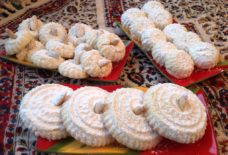Coffee Culture Is Grounds For New Arab Musuem Exhibition
OK, Coffee Achievers…it’s time to test your knowledge. Sure, you know the difference between an iced single venti mocha, no whip and a double tall cappuccino, extra dry at Starbucks. But what do you REALLY know about the history of your favorite bean, the second-most commonly traded commodity (after oil) on planet Earth? Here’s a quick quiz:
“Mocha” is:
a) espresso with steamed milk, flavored with chocolate
b) a chain of coffee shops in India
c) a port city in Yemen, in the Arab World
d) the name of a software product
The answer is…all of the above! However, you’re not alone if you were very surprised to learn that the Red Sea port city of Mocha, Yemen, was the source of coffee beans with a natural chocolate taste, inspiring the flavored mocha drinks we enjoy today. In fact, it was Yemenis who first purposefully cultivated coffee plants after travelers brought home beans native to Ethiopia and the Horn of Africa. That species, named coffea arabica for its place of cultivation, today accounts for 75% of world coffee production.
“Coffee culture” as we know it has come a long way from its origins in the Arab World. Many myths surround the discovery of this fascinating beverage, but it is coffee’s Arab cultural roots that have led to continuing social traditions, the global institution we know as the coffeehouse and even some of the greatest revelations in human history.
Take a break from the daily grind to drink it all in at the Arab American National Museum’s (AANM) new exhibition From Mocha to Latte: Coffee, the Arab World and the $4 Cup. It explores the effects of coffee on the history of the Arab World and consequently, the rest of the world. The exhibition runs January 28 – August 15, 2010 in the Lower Level Gallery. It’s free with Museum admission; every visitor also gets a free cup of coffee (tea or hot chocolate also available) to enjoy during the show.
The public is invited to a free opening reception at 5:30 p.m. Thursday, January 28, 2010 in the AANM’s dramatic Community Courtyard, featuring complimentary Arabic coffee and sweets, sponsored by Hashem Roastery of Dearborn.
Later that same evening, at 6:30 p.m., the Winter Spring 2010 season of Global Thursdays opens with a passionate performance by renowned Lebanese nay virtuoso and multi-instrumentalist Bassam Saba. Advance tickets and the complete Global Thursdays schedule are available at www.arabamericanmuseum.org.
Coffee is consumed the world over, but several areas, including parts of Asia, Africa and Central and South America, are most commonly associated with coffee history, cultivation and culture in the public consciousness.
“Coffee is both a unifying beverage as much as it is a division because each culture has adapted to coffee in a slightly different way,” says Elizabeth Barrett, AANM curator. “The serving traditions, the local blends and advertising are unique to their regions, but all revolve around this one miraculous beverage.”
AANM Curatorial Department Manager Stephen Williams maintains there is plenty of evidence showing coffee’s amazing impact on global history and society. “For example, coffee really fueled the Industrial Revolution. Earlier Europeans were always a little bit ‘under the influence,’ consuming beer morning, noon and night, because safe drinking water was scarce,” Williams says.
Such impairment could pose a serious danger working with heavy machinery in the new factories. “Coffee, on the other hand, tended to make workers more alert. Companies even encouraged ‘coffee breaks’ to boost productivity,” says Williams.


